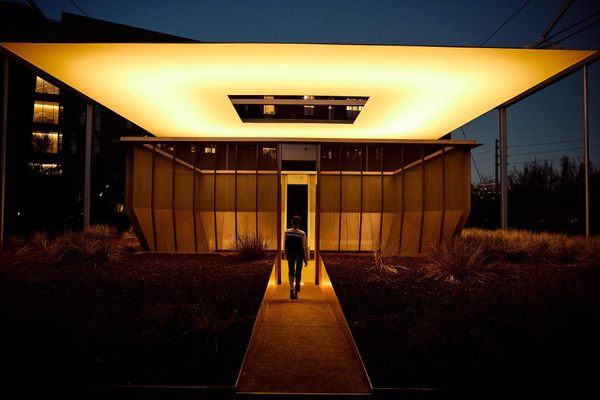In Tempe, Arizona, the sky looms large. The horizons are broad, and the sun shines more than 300 days a year. It’s hard to imagine a more fitting location for an installation by the Arizona-based artist James Turrell, known for his Skyspaces, a series of works that inspire visitors to ponder the connections between light, space, color, and the natural world.
Installed on the campus of Arizona State University in 2012 and titled “Air Apparent,” this remarkable work allows viewers to reset their connection with the sky. Visitors approach the space along a path that leads through a desert garden, before entering a roofless square open structure. Benches along the inside perimeter allow for about 50 people to sit. Above hangs a square sheet of steel, 45 feet on every side, with a cutout in the center, also square, measuring 15 feet per side.
“There is this sense of peace and everything stopping when you walk into the space,” said Deborah Sussman, who has been visiting the space regularly since it opened.
“People immediately speak a little bit more quietly,” added Sussman, the senior director of communications and marketing at ASU’s Herberger Institute for Design and the Arts.
Inside, visitors tend to be transfixed by the square patch of sky above, reframed by the artist in a way that tends to inspire awe. The sky, so vast and familiar that it rarely commands our attention, is renewed as something dynamic. The square plane changes color, of course, as the day proceeds, with occasional interruptions—clouds, airplanes, or birds.
But the most electrifying experience comes at sunrise and sunset, when Turrell’s deep understanding of light and color are fully revealed. A system of 480 colored LED lights, carefully concealed in the structure, illuminates the steel plate from below, in a programmed display that changes as the sun rises or sets. These lights in turn change the viewer’s perception of the sky and the surrounding environment, as the color combinations go from contrasting to complementary.
“At the end of it, you feel altered,” said Sussman. “In the way that a poem can make you see the world differently, that’s what this does.”
It’s one of her favorite place to take visitors to Tempe.
Designed by Turrell in collaboration with the Tempe-based architect Will Bruder, “Air Apparent” also evokes the construction of buildings by the Hohokam, an indigenous people who occupied the region from around the year 300 to 1500.
The Hohokam are known for building complex irrigation systems, so essential to desert life; as well as pithouses, low structures built atop excavated earth—a rich connection to ponder during the immersive experience of Turrell’s creation.


